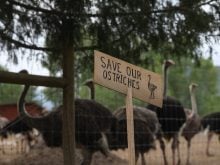Dale Cochrane responded to a Sunday call a week ago. That is not unusual for a rural veterinarian, but the rabid cow he found in the corral was.
Cochrane said it was only the second time in his 25-year practice that he had found a cow with the condition.
The Melville, Sask., vet says he has seen an increase in the skunk population and with it, a rising risk to pets and livestock.
“We have had to put down a few dogs and cats that were exposed to a positive skunk. We haven’t actually seen a lot of rabies in pets though,” said Cochrane. He said more producers are choosing to inoculate their pets and horses.
Read Also

VIDEO: Agritechnica Day 4: Robots and more robots, Nexat loves Canada and the trouble with tariffs
Agritechnica Day 4: Robots and more robots, Nexat loves Canada and the trouble with tariffs.
Veterinarians on the eastern side of the province and in Manitoba are reporting the highest occurrence of infected skunks in years, said the federal veterinarian from Yorkton, Sask.
Terrance Bishop, of Agriculture Canada, said a horse was found infected near Yorkton.
“Producers should be aware of the risk of rabies and know what the signs of rabies are,” he said.
Cochrane agrees: “If any animal is acting strangely, nervous or walking poorly then rabies should be considered.”
Bishop said while it is unusual, farmers have to be careful in handling an animal that is suspected of having rabies.
“Cattle don’t yawn,” said Bishop. “When they have rabies they can appear to be yawning or trying to expel something from their throats. That is when farmers get exposed to the rabies. They try to reach down the animal’s throat and they get bitten.”














